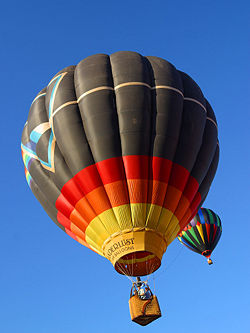Hot air balloon: Difference between revisions
Jump to navigation
Jump to search

imported>Anton Sweeney m (fix link) |
imported>Subpagination Bot m (Add {{subpages}} and remove any categories (details)) |
||
| Line 1: | Line 1: | ||
{{subpages}} | |||
[[Image:Hot air balloons in flight.jpg|right|thumb|250px|{{#ifexist:Template:Hot air balloons in flight.jpg/credit|{{Hot air balloons in flight.jpg/credit}}<br/>|}}Hot air balloons in flight.]] | [[Image:Hot air balloons in flight.jpg|right|thumb|250px|{{#ifexist:Template:Hot air balloons in flight.jpg/credit|{{Hot air balloons in flight.jpg/credit}}<br/>|}}Hot air balloons in flight.]] | ||
'''Hot air balloons''' are the most popular type of [[buoyancy|buoyant]] [[aircraft]]. | '''Hot air balloons''' are the most popular type of [[buoyancy|buoyant]] [[aircraft]]. | ||
| Line 8: | Line 10: | ||
obtained by heating air, typically with a [[propane]] burner, rather than | obtained by heating air, typically with a [[propane]] burner, rather than | ||
using an unheated gas such as [[Helium]]. | using an unheated gas such as [[Helium]]. | ||
Revision as of 16:00, 27 January 2008
Hot air balloons are the most popular type of buoyant aircraft.
Hot air balloons were the first type of aircraft to carry humans. The first one was built by the Montgofier brothers and flown in Paris in 1783.
Hot air balloons are distinct from gas balloons in that their buoyancy is obtained by heating air, typically with a propane burner, rather than using an unheated gas such as Helium.
